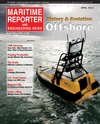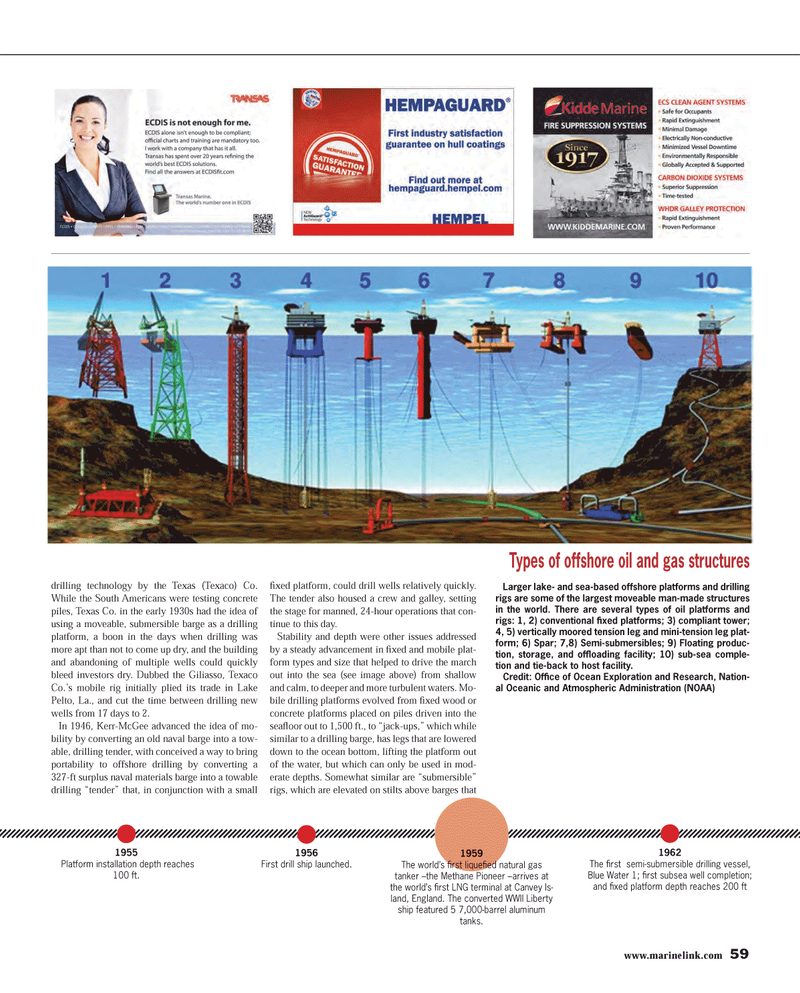
Page 59: of Maritime Reporter Magazine (April 2014)
Offshore Edition
Read this page in Pdf, Flash or Html5 edition of April 2014 Maritime Reporter Magazine
www.marinelink.com 59drilling technology by the Texas (Texaco) Co. While the South Americans were testing concrete piles, Texas Co. in the early 1930s had the idea of using a moveable, submersible barge as a drilling platform, a boon in the days when drilling was more apt than not to come up dry, and the building and abandoning of multiple wells could quickly bleed investors dry. Dubbed the Giliasso, Texaco Co.?s mobile rig initially plied its trade in Lake Pelto, La., and cut the time between drilling new wells from 17 days to 2. In 1946, Kerr-McGee advanced the idea of mo- bility by converting an old naval barge into a tow- able, drilling tender, with conceived a way to bring portability to offshore drilling by converting a 327-ft surplus naval materials barge into a towable drilling ?tender? that, in conjunction with a small Þ xed platform, could drill wells relatively quickly. The tender also housed a crew and galley, setting the stage for manned, 24-hour operations that con-tinue to this day. Stability and depth were other issues addressed by a steady advancement in Þ xed and mobile plat- form types and size that helped to drive the march out into the sea (see image above) from shallow and calm, to deeper and more turbulent waters. Mo-bile drilling platforms evolved from Þ xed wood or concrete platforms placed on piles driven into the seaß oor out to 1,500 ft., to ?jack-ups,? which while similar to a drilling barge, has legs that are lowered down to the ocean bottom, lifting the platform out of the water, but which can only be used in mod- erate depths. Somewhat similar are ?submersible? rigs, which are elevated on stilts above barges that 1955 Platform installation depth reaches 100 ft. 1956First drill ship launched.1962The Þ rst semi-submersible drilling vessel, Blue Water 1; Þ rst subsea well completion; and Þ xed platform depth reaches 200 ft Types of offshore oil and gas structures Larger lake- and sea-based offshore platforms and drilling rigs are some of the largest moveable man-made structures in the world. There are several types of oil platforms and rigs: 1, 2) conventional Þ xed platforms; 3) compliant tower; 4, 5) vertically moored tension leg and mini-tension leg plat- form; 6) Spar; 7,8) Semi-submersibles; 9) Floating produc- tion, storage, and ofß oading facility; 10) sub-sea comple- tion and tie-back to host facility. Credit: OfÞ ce of Ocean Exploration and Research, Nation- al Oceanic and Atmospheric Administration (NOAA)1959The worldÕs Þ rst liqueÞ ed natural gas tanker Ðthe Methane Pioneer Ðarrives at the worldÕs Þ rst LNG terminal at Canvey Is- land, England. The converted WWII Liberty ship featured 5 7,000-barrel aluminum tanks. MR #4 (56-65).indd 59MR #4 (56-65).indd 594/7/2014 3:13:52 PM4/7/2014 3:13:52 PM

 58
58

 60
60
